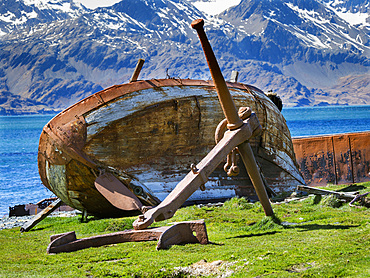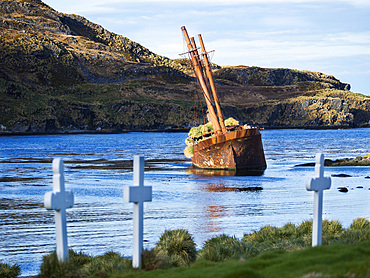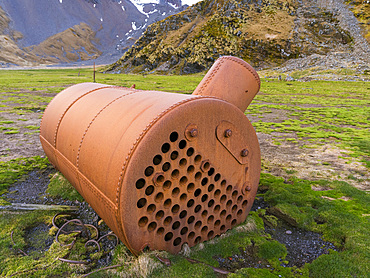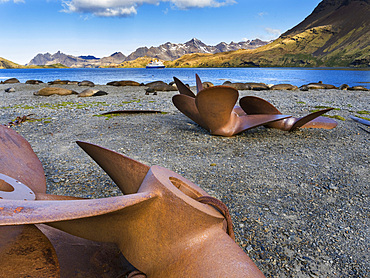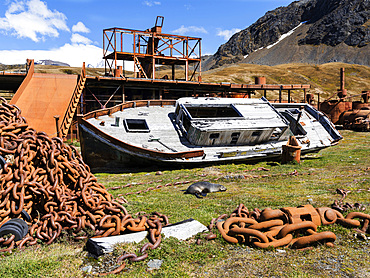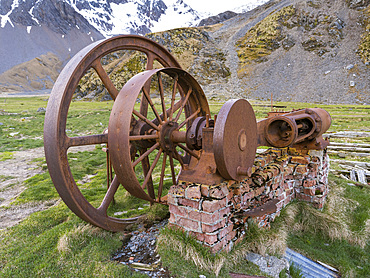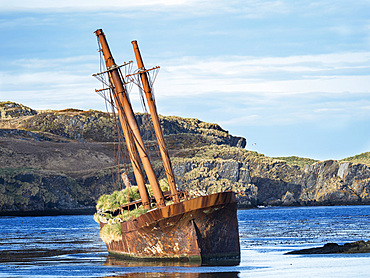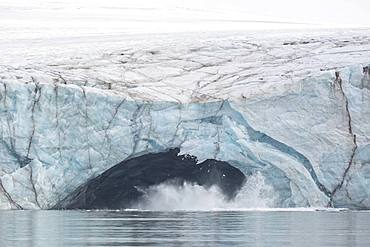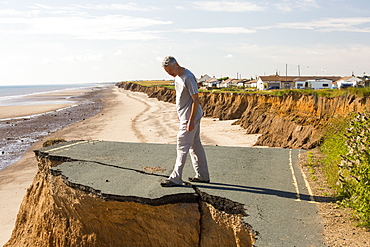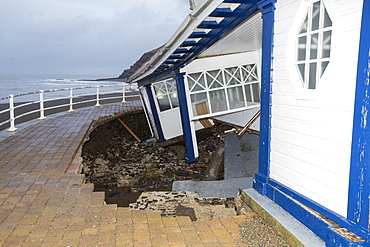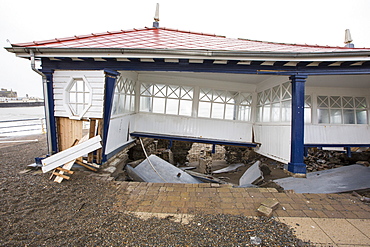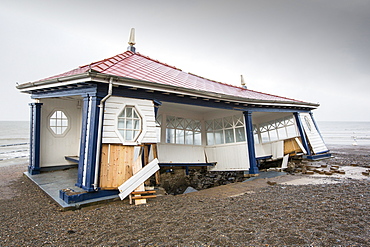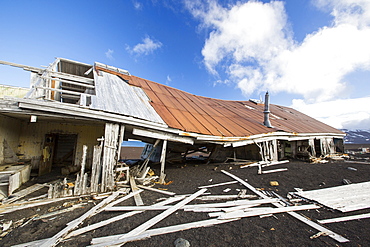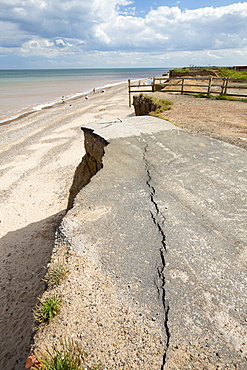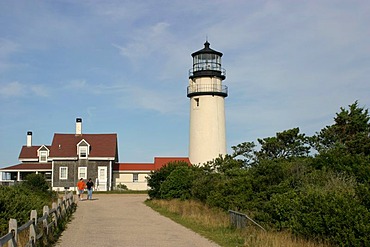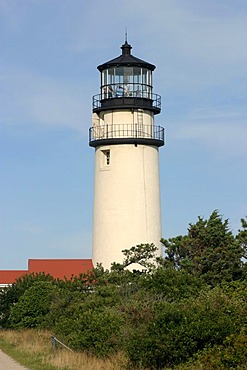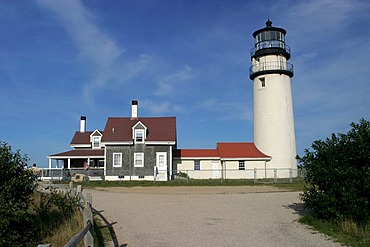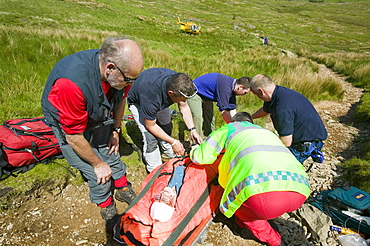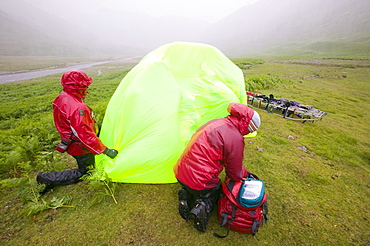Recent searches
Loading...
746-91114 - The church. Grytviken Whaling Station in South Georgia. Grytviken is open to visitors, but most walls and roofs of the factory have been demolished for safety reasons. Antarctica, Subantarctica, South Georgia, October
746-91110 - Wreck of a small ship. Grytviken Whaling Station in South Georgia. Grytviken is open to visitors, but most walls and roofs of the factory have been demolished for safety reasons. Antarctica, Subantarctica, South Georgia, October
746-91119 - Wreck of the Bayard in Ocean Harbour a whaling station in South Georgia, with a colony of South Georgia Shag (Phalacrocorax georgianus). Antarctica, Subantarctica, South Georgia, October
746-91113 - The Petrel a whale catcher. Grytviken Whaling Station in South Georgia. Grytviken is open to visitors, but most walls and roofs of the factory have been demolished for safety reasons. Antarctica, Subantarctica, South Georgia, October
746-91112 - The Petrel a whale catcher. Grytviken Whaling Station in South Georgia. Grytviken is open to visitors, but most walls and roofs of the factory have been demolished for safety reasons. Antarctica, Subantarctica, South Georgia, October
746-91117 - Ruins of the whaling station Ocean Harbour in South Georgia. Antarctica, Subantarctica, South Georgia, October
746-91111 - Wreck of the Dias in Grytviken. Grytviken Whaling Station in South Georgia. Grytviken is open to visitors, but most walls and roofs of the factory have been demolished for safety reasons. Antarctica, Subantarctica, South Georgia, October
746-91115 - Ruins of Stromness Whaling Station in South Georgia Antarctica, Subantarctica, South Georgia, October
746-91109 - Wreck with Antarctic Fur Seal (Arctocephalus gazella) on the former Flensing Plan. Grytviken Whaling Station in South Georgia. Grytviken is open to visitors, but most walls and roofs of the factory have been demolished for safety reasons. Antarctica, Subantarctica, South Georgia, October
746-91108 - The former Flensing Plan. Grytviken Whaling Station in South Georgia. Grytviken is open to visitors, but most walls and roofs of the factory have been demolished for safety reasons. Antarctica, Subantarctica, South Georgia, October
746-91116 - Ruins of Stromness Whaling Station in South Georgia, sign to ban access to the station. Antarctica, Subantarctica, South Georgia, October
746-91118 - Ruins of the whaling station Ocean Harbour in South Georgia. Antarctica, Subantarctica, South Georgia, October
746-91120 - Wreck of the Bayard in Ocean Harbour a whaling station in South Georgia, with a colony of South Georgia Shag (Phalacrocorax georgianus). Antarctica, Subantarctica, South Georgia, October
746-91107 - Cemetery. Grytviken Whaling Station in South Georgia. Grytviken is open to visitors, but most walls and roofs of the factory have been demolished for safety reasons. Antarctica, Subantarctica, South Georgia, October
860-287071 - Calving or collapse of glacier Pedasenkobreen, Spitzberg, Svalbard
860-287072 - Calving or collapse of glacier Pedasenkobreen, Spitzberg, Svalbard
860-287073 - Calving or collapse of glacier Pedasenkobreen, Spitzberg, Svalbard
860-287074 - Calving or collapse of glacier Pedasenkobreen, Spitzberg, Svalbard
1116-42561 - Sign To Warn Of Strong Winds, Waves And Cliff Collapse, Big Island, Hawaii, United States Of America
857-95431 - A collapsed coastal road at between Skipsea and Ulrome on Yorkshires East Coast, near Skipsea, UK. The coast is composed of soft boulder clays, very vulnerable to coastal erosion. This section of coast has been eroding since Roman times, with many villages having disappeared into the sea, and is the fastest eroding coast in Europe. Climate change is speeding up the erosion, with sea level rise, increased stormy weather and increased heavy rainfall events, all playing their part.
857-95432 - A collapsed coastal road at between Skipsea and Ulrome on Yorkshires East Coast, near Skipsea, UK. The coast is composed of soft boulder clays, very vulnerable to coastal erosion. This section of coast has been eroding since Roman times, with many villages having disappeared into the sea, and is the fastest eroding coast in Europe. Climate change is speeding up the erosion, with sea level rise, increased stormy weather and increased heavy rainfall events, all playing their part.
857-95435 - A collapsed coastal road at near Aldbrough on Yorkshires East Coast, near Skipsea, UK. The coast is composed of soft boulder clays, very vulnerable to coastal erosion. This section of coast has been eroding since Roman times, with many villages having disappeared into the sea, and is the fastest eroding coast in Europe. Climate change is speeding up the erosion, with sea level rise, increased stormy weather and increased heavy rainfall events, all playing their part.
857-95433 - A collapsed coastal road at between Skipsea and Ulrome on Yorkshires East Coast, near Skipsea, UK. The coast is composed of soft boulder clays, very vulnerable to coastal erosion. This section of coast has been eroding since Roman times, with many villages having disappeared into the sea, and is the fastest eroding coast in Europe. Climate change is speeding up the erosion, with sea level rise, increased stormy weather and increased heavy rainfall events, all playing their part.
857-95437 - A collapsed coastal road at between Skipsea and Ulrome on Yorkshires East Coast, near Skipsea, UK. The coast is composed of soft boulder clays, very vulnerable to coastal erosion. This section of coast has been eroding since Roman times, with many villages having disappeared into the sea, and is the fastest eroding coast in Europe. Climate change is speeding up the erosion, with sea level rise, increased stormy weather and increased heavy rainfall events, all playing their part.
857-95436 - A collapsed coastal road at between Skipsea and Ulrome on Yorkshires East Coast, near Skipsea, UK. The coast is composed of soft boulder clays, very vulnerable to coastal erosion. This section of coast has been eroding since Roman times, with many villages having disappeared into the sea, and is the fastest eroding coast in Europe. Climate change is speeding up the erosion, with sea level rise, increased stormy weather and increased heavy rainfall events, all playing their part.
857-95434 - A collapsed coastal road at Barmston on Yorkshires East Coast, near Skipsea, UK. The coast is composed of soft boulder clays, very vulnerable to coastal erosion. This section of coast has been eroding since Roman times, with many villages having disappeared into the sea, and is the fastest eroding coast in Europe. Climate change is speeding up the erosion, with sea level rise, increased stormy weather and increased heavy rainfall events, all playing their part.
857-95438 - Smashed concrete sea defenses at Ulrome near Skipsea on Yorkshires East Coast, UK. The sea has eroded past the barriers and left them stranded further down the beach. The coast is composed of soft boulder clays, very vulnerable to coastal erosion. This section of coast has been eroding since Roman times, with many villages having disappeared into the sea, and is the fastest eroding coast in Europe. Climate change is speeding up the erosion, with sea level rise, increased stormy weather and increased heavy rainfall events, all playing their part.
911-10890 - A road eroded and dropping off into the North sea at Happisburgh, Norfolk, a rapidly eroding section of coastline, UK.
911-10891 - A road eroded and dropping off into the North sea at Happisburgh, Norfolk, a rapidly eroding section of coastline, UK.
911-10750 - The Remains of the Godwin battery on the beach at Kilnsea at the head of Spurn point on Yorkshires East Coast, UK. Initially constructed during the First World War, the Godwin Battery was added to during the Second World War. It comprised of gun emplacements, search light, barracks, officers’ mess, and a hospital. This section of coastline is the fastest eroding coastline in Europe. The soft boulder clay cliffs are easily eroded and have been eroding since Roman Times, but recently the climate change impacts of increased stormy weather, increased heavy rainfall events and sea level rise have accelerated the rate of erosion. The average rate of attrition is 1.5metres per year, last year it was 5 metres.
911-10758 - After a week of high tides, storm surges and storm force winds, the sea front promenade of Aberystwyth in Wales has been devastated, with millions of £'s of damage. The crsahing waves punched a large hole in the sea wall and has collapsed Aberystwyth's iconic, Victorian promenade shelter, which has stood for over 100 years. This picture was taken on Wednesday 8th January, 2014, the day the council started to try and clear the thousands of tonnes of beach rubble off the sea front road.
911-10756 - After a week of high tides, storm surges and storm force winds, the sea front promenade of Aberystwyth in Wales has been devastated, with millions of £'s of damage. The crsahing waves punched a large hole in the sea wall and has collapsed Aberystwyth's iconic, Victorian promenade shelter, which has stood for over 100 years. This picture was taken on Wednesday 8th January, 2014, the day the council started to try and clear the thousands of tonnes of beach rubble off the sea front road.
911-10749 - The Remains of the Godwin battery on the beach at Kilnsea at the head of Spurn point on Yorkshires East Coast, UK. Initially constructed during the First World War, the Godwin Battery was added to during the Second World War. It comprised of gun emplacements, search light, barracks, officers’ mess, and a hospital. This section of coastline is the fastest eroding coastline in Europe. The soft boulder clay cliffs are easily eroded and have been eroding since Roman Times, but recently the climate change impacts of increased stormy weather, increased heavy rainfall events and sea level rise have accelerated the rate of erosion. The average rate of attrition is 1.5metres per year, last year it was 5 metres.
911-10757 - After a week of high tides, storm surges and storm force winds, the sea front promenade of Aberystwyth in Wales has been devastated, with millions of £'s of damage. The crsahing waves punched a large hole in the sea wall and has collapsed Aberystwyth's iconic, Victorian promenade shelter, which has stood for over 100 years. This picture was taken on Wednesday 8th January, 2014, the day the council started to try and clear the thousands of tonnes of beach rubble off the sea front road.
911-10166 - Dunes collapsing at the head of the beach on the Northumberland coast after being undercut by a storm and high tide.
911-10193 - The old British Antarctic Survey station on Deception Island in the South Shetland Islands off the Antarctic Peninsular which is an active volcanic caldera. It was abandoned in 1967 when it was over run by a volcanic eruption.
911-10173 - A holiday chalet in the sand dunes at low Newton by the Sea on Northumberland's coast stands precarioulsy close to the edge following a severe storm surge in December 2013 that caused considerable erosion to the sand dunes.
911-10073 - A collapsed coastal road at Barmston on Yorkshires East Coast, near Skipsea, UK. The coast is composed of soft boulder clays, very vulnerable to coastal erosion. This sectiion of coast has been eroding since Roman times, with many villages having disappeared into the sea, and is the fastest eroding coast in Europe. Climate change is speeding up the erosion, with sea level rise, increased stormy weather and increased heavy rainfall events, all palying their part.
911-10074 - A Second world War lookout post leaning alarmingly and about to tumble over the edge of the cliff near Aldbrough on Yorkshires East Coast, UK. The coast is composed of soft boulder clays, very vulnerable to coastal erosion. This section of coast has been eroding since Roman times, with many villages having disappeared into the sea, and is the fastest eroding coast in Europe. Climate change is speeding up the erosion, with sea level rise, increased stormy weather and increased heavy rainfall events, all playing their part.
911-10071 - A collapsed coastal road at between Skipsea and Ulrome on Yorkshires East Coast, near Skipsea, UK. The coast is composed of soft boulder clays, very vulnerable to coastal erosion. This sectiion of coast has been eroding since Roman times, with many villages having disappeared into the sea, and is the fastest eroding coast in Europe. Climate change is speeding up the erosion, with sea level rise, increased stormy weather and increased heavy rainfall events, all palying their part.
911-10069 - Concrete sea defences at Beach Bank Caravan Park in Ulrome near Skipsea on Yorkshires East Coast, UK. The coast is composed of soft boulder clays, very vulnerable to coastal erosion. This section of coast has been eroding since Roman times, with many villages having disappeared into the sea, and is the fastest eroding coast in Europe. Climate change is speeding up the erosion, with sea level rise, increased stormy weather and increased heavy rainfall events, all playing their part.
911-10070 - A collapsed coastal road at near Aldbrough on Yorkshires East Coast, near Skipsea, UK. The coast is composed of soft boulder clays, very vulnerable to coastal erosion. This sectiion of coast has been eroding since Roman times, with many villages having disappeared into the sea, and is the fastest eroding coast in Europe. Climate change is speeding up the erosion, with sea level rise, increased stormy weather and increased heavy rainfall events, all palying their part.
911-10066 - A collapsed coastal road at Easingotn on Yorkshires East Coast, near Skipsea, UK. The coast is composed of soft boulder clays, very vulnerable to coastal erosion. This sectiion of coast has been eroding since Roman times, with many villages having disappeared into the sea, and is the fastest eroding coast in Europe. Climate change is speeding up the erosion, with sea level rise, increased stormy weather and increased heavy rainfall events, all palying their part.
911-10068 - A collapsed coastal road at between Skipsea and Ulrome on Yorkshires East Coast, near Skipsea, UK. The coast is composed of soft boulder clays, very vulnerable to coastal erosion. This sectiion of coast has been eroding since Roman times, with many villages having disappeared into the sea, and is the fastest eroding coast in Europe. Climate change is speeding up the erosion, with sea level rise, increased stormy weather and increased heavy rainfall events, all palying their part.
911-10072 - A collapsed coastal road at between Skipsea and Ulrome on Yorkshires East Coast, near Skipsea, UK. The coast is composed of soft boulder clays, very vulnerable to coastal erosion. This sectiion of coast has been eroding since Roman times, with many villages having disappeared into the sea, and is the fastest eroding coast in Europe. Climate change is speeding up the erosion, with sea level rise, increased stormy weather and increased heavy rainfall events, all palying their part.
911-10067 - A collapsed coastal road near Skipsea on Yorkshires East Coast, UK. The coast is composed of soft boulder clays, very vulnerable to coastal erosion. This sectiion of coast has been eroding since Roman times, with many villages having disappeared into the sea, and is the fastest eroding coast in Europe. Climate change is speeding up the erosion, with sea level rise, increased stormy weather and increased heavy rainfall events, all playing their part.
832-337094 - Highland Light (Cape Cod Light). The station was established in 1797, the present buildings date from 1857. At that time, the lighthouse was still 150m away from the 40m cliffs, but continuing erosion imperiled the location. At the end of the 20th century
832-337093 - Highland Light (Cape Cod Light). The station was established in 1797, the present buildings date from 1857. At that time, the lighthouse was still 150m away from the 40m cliffs, but continuing erosion imperiled the location. At the end of the 20th century
832-337089 - Highland Light (Cape Cod Light). The station was established in 1797, the present buildings date from 1857. At that time, the lighthouse was still 150m away from the 40m cliffs, but continuing erosion imperiled the location. At the end of the 20th century
1161-2572 - Buildings demolished in earthquake area of Azad Jammu Kashmir, in village of Pattika, Pakistan
1161-2577 - Demolished buildings seen from helicopter in earthquake area of Azad Jammu Kashmir, Pakistan
1161-2575 - Buildings demolished in earthquake area of Azad Jammu Kashmir, in village of Pattika, Pakistan
1161-2569 - Buildings demolished in earthquake area of Azad Jammu Kashmir, in village of Pattika, Pakistan
1161-2568 - Buildings demolished in earthquake area of Azad Jammu Kashmir, in village of Pattika, Pakistan
1161-2574 - Buildings demolished in earthquake area of Azad Jammu Kashmir, in village of Pattika, Pakistan
1161-2567 - Buildings demolished in earthquake devastated area of Azad Jammu Kashmir, in village of Pattika, Pakistan
1161-2573 - Buildings demolished in earthquake area of Azad Jammu Kashmir, in village of Pattika, Pakistan
1161-2570 - Buildings demolished in earthquake area of Azad Jammu Kashmir, in village of Pattika, Pakistan
1161-2576 - Demolished buildings seen from helicopter in earthquake area of Azad Jammu Kashmir, Pakistan
1161-2571 - Buildings demolished in earthquake area of Azad Jammu Kashmir, village of Pattika, Pakistan
832-215077 - Aerial view, collapse of the Historical Archive of the City of Cologne, Cologne, North Rhine-Westphalia, Germany, Europe
1116-17880 - Twisted Barn on Canadian Prairie, Big Muddy Badlands, Saskatchewan
1116-18752 - Falling Granary at Sunrise, Prairies in Edmonton, Alberta
979-3067 - Views of the dilapidates former cannery site at Butedale along the inside passage in British Columbia, Canada, Pacific Ocean.
979-3066 - Views of the dilapidates former cannery site at Butedale along the inside passage in British Columbia, Canada, Pacific Ocean. (rr)
911-2480 - Aialick Glacier receding rapidly due to climate change, in Kenai Fjords National Park in Alaska, United States of America, North America
911-2554 - House collapsed due to global warming-induced permafrost melt, Fairbanks, Alaska, United States of America, North America
911-2479 - Aialick Glacier receding rapidly due to climate change, in Kenai Fjords National Park in Alaska, United States of America, North America
911-148 - The Russell Glacier draining the Greenland icesheet inland from Kangerlussuaq on Greenlands west coast, Greenland, Polar Regions
911-2473 - Aialick Glacier receding rapidly due to climate change, in Kenai Fjords National Park in Alaska, United States of America, North America
911-3397 - A rock fall on Ben Starav in Glen Etive, Highlands, Scotland, United Kingdom, Europe
911-2819 - A rock fall on Ben Starav in Glen Etive, Highlands, Scotland, United Kingdom, Europe
911-7493 - A large section of road collapsed betwwen Skelwyth and Elterwater in the Langdale Valley, Lake District, Cumbria, England, United Kingdom, Europe
911-6754 - Tarmac road washed away at Happisburgh, North Norfolk, Norfolk, England, United Kingdom, Europe
911-6695 - Happisburgh, on one of the most rapidly eroding coastlines in the British Isles, North Norfolk, England, United Kingdom, Europe
911-6697 - Happisburgh, on one of the most rapidly eroding coastlines in the British Isles, North Norfolk, England, United Kingdom, Europe
911-6674 - Ramp in the foreground used to be the lifeboat launching ramp until it was destroyed by coastal erosion, Happisburgh, North Norfolk, England, United Kingdom, Europe
911-6412 - Eroded river bank in the Trough of Bowland, Lancashire, England, United Kingdom, Europe
911-1914 - A search dog locates a walker collapsed with hypothermia in the Lake District, Cumbria, England, United Kingdom, Europe
911-1915 - Members of Langdale Ambleside mountain rescue Team treat a collapsed walker suffering from hypothermia in the Lake District, Cumbria, England, United Kingdom, Europe
911-2444 - Autumn and winter storms eroding the coastline of Shishmaref, a tiny island inhabited by around 600 Inuits, between Alaska and Siberia in the Chukchi Sea, United States of America, North America
911-2559 - Detail of cracks in a house collapsing due to global warming-induced permafrost melt, Fairbanks, Alaska, United States of America, North America
911-2474 - Aialick Glacier receding rapidly due to climate change, in Kenai Fjords National Park in Alaska, United States of America, North America
911-1984 - An air ambulance attends a mountain rescue on Wansfell, Lake District, Cumbria, England, United Kingdom, Europe
911-2545 - Drunken Forest where trees collapse due to global warming-induced permafrost melt, Fairbanks, Alaska, United States of America, North America
911-2447 - Exit Glacier has retreated rapidly due to global warming, Kenai Fjords National Park, Alaska, United States of America, North America
911-7731 - A new build housing development that was abandoned when the Spanish economy collapsed during the recession, causing the developer to become bankrupt, near Sanlucar La Mayor, Spain.
911-7730 - A new build housing development that was abandoned when the Spanish economy collapsed during the recession, causing the developer to become bankrupt, near Sanlucar La Mayor, Spain.
911-2558 - House collapsing due to global warming-induced permafrost melt, Fairbanks, Alaska, United States of America, North America
911-6698 - Houses that have already lost gardens to the sea on one of the most rapidly eroding coastlines in the British Isles, Happisburgh, North Norfolk, England, United Kingdom, Europe
911-6696 - Happisburgh, on one of the most rapidly eroding coastlines in the British Isles, North Norfolk, England, United Kingdom, Europe
911-6347 - House in Keswick next to the River Greta, collapsed after it was undermined by the flood waters, Keswick, Lake District, Cumbria, England, United Kingdom, Europe
911-2478 - Aialick Glacier receding rapidly due to climate change, in Kenai Fjords National Park in Alaska, United States of America, North America
911-2544 - Drunken Forest where trees collapse due to global warming-induced permafrost melt, Fairbanks, Alaska, United States of America, North America
911-2445 - Autumn and winter storms eroding the coastline of Shishmaref, a tiny island inhabited by around 600 Inuits, between Alaska and Siberia in the Chukchi Sea, United States of America, North America
911-1917 - Members of Langdale Ambleside mountain rescue Team treat a collapsed walker suffering from hypothermia protected from the foul weather by a group shelter, Lake District, Cumbria, England, United Kingdom, Europe
911-2548 - Drunken Forest where trees collapse due to global warming-induced permafrost melt, Fairbanks, Alaska, United States of America, North America
911-2557 - House collapsing due to global warming-induced permafrost melt, Fairbanks, Alaska, United States of America, North America
911-2546 - House collapsing due to global warming-induced permafrost melt, Fairbanks, Alaska, United States of America, North America
911-2446 - Exit Glacier has retreated rapidly due to global warming, Kenai Fjords National Park, Alaska, United States of America, North America

